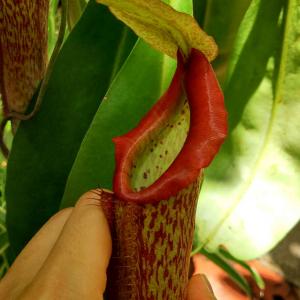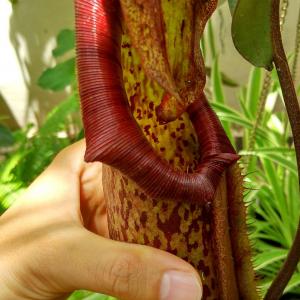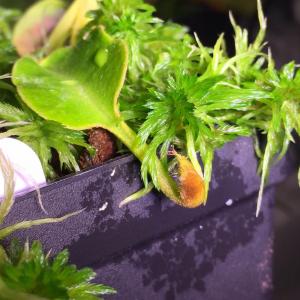文章
Dummer. ゛☀
2017年08月19日

Nepenthes, often called pitcher plants, are native to tropical regions in South East Asia, India, Madagascar and Australia. They get their common name from the swellings in the mid-veins of the leaves that look like small pitchers. Nepenthes pitcher plants are often grown as houseplants in cooler climates. If you own one, you may see your pitcher plant leaves turning red. There are various possible reasons for a pitcher plant with red leaves; some require fixing, some do not.
Nepenthes Pitcher Plants
Nepenthes pitcher plants use their pitchers to attract insects, not for pollination but for nutrition. Insects are attracted to the pitchers by their nectar secretions and coloration. The rim and inner walls of the leaf swelling are slippery, causing visiting insects to slide into the pitcher. They get trapped in the digestive fluid, and absorbed by the nepenthes pitcher plants for their nutrients.
Pitcher Plant with Red Leaves
The standard color for mature pitcher plant leaves is green. If you see your pitcher plant leaves turning red, it may or may not signal a problem. If the pitcher plant leaves turning red are young leaves, the coloration can be perfectly normal. New leaves often grow in with a distinct reddish tinge. If, on the other hand, you see mature pitcher plant leaves turning red, it can be a cause for concern. You can determine whether a leaf is mature or new by its placement on the vine. Read on for information about fixing a nepenthes with red leaves.
Fixing a Nepenthes with Red Leaves
Too Much Light
Pitcher plants with red leaves can signal “sunburn,” caused by too much light. They generally require bright light, but not too much direct sun. Indoor plants can thrive with plant lights as long as they are broad spectrum and kept sufficiently far away to prevent overheating or scorching. Too much light can cause the leaves facing the light to turn red. Fix this problem by moving the plant farther from the light source.
Too Little Phosphorous
If your pitcher plant leaves become deep red in autumn, it can indicate inadequate phosphorus. Carnivorous nepenthes pitcher plants get phosphorus from the insects they attract and digest. These plants use phosphorus from insect meals to augment the green chlorophyll in its leaves for photosynthesis. A pitcher plant with red leaves may not have consumed enough insects to do this. One solution is to add small insects, like flies, to your mature pitchers.

Nepenthes Pitcher Plants
Nepenthes pitcher plants use their pitchers to attract insects, not for pollination but for nutrition. Insects are attracted to the pitchers by their nectar secretions and coloration. The rim and inner walls of the leaf swelling are slippery, causing visiting insects to slide into the pitcher. They get trapped in the digestive fluid, and absorbed by the nepenthes pitcher plants for their nutrients.

Pitcher Plant with Red Leaves
The standard color for mature pitcher plant leaves is green. If you see your pitcher plant leaves turning red, it may or may not signal a problem. If the pitcher plant leaves turning red are young leaves, the coloration can be perfectly normal. New leaves often grow in with a distinct reddish tinge. If, on the other hand, you see mature pitcher plant leaves turning red, it can be a cause for concern. You can determine whether a leaf is mature or new by its placement on the vine. Read on for information about fixing a nepenthes with red leaves.

Fixing a Nepenthes with Red Leaves
Too Much Light
Pitcher plants with red leaves can signal “sunburn,” caused by too much light. They generally require bright light, but not too much direct sun. Indoor plants can thrive with plant lights as long as they are broad spectrum and kept sufficiently far away to prevent overheating or scorching. Too much light can cause the leaves facing the light to turn red. Fix this problem by moving the plant farther from the light source.
Too Little Phosphorous
If your pitcher plant leaves become deep red in autumn, it can indicate inadequate phosphorus. Carnivorous nepenthes pitcher plants get phosphorus from the insects they attract and digest. These plants use phosphorus from insect meals to augment the green chlorophyll in its leaves for photosynthesis. A pitcher plant with red leaves may not have consumed enough insects to do this. One solution is to add small insects, like flies, to your mature pitchers.
1
0
Misspgy:Such an AMAZING plant plus all your pictures are so Q
文章
Dummer. ゛☀
2017年08月19日

Nepenthes (pitcher plants) are fascinating plants that survive by secreting sweet nectar that lures insects to the plant’s cup-like pitchers. Once the unsuspecting insect slides into the slippery pitcher, the plant’s fluids digest the bug in soupy, sticky liquid. There are many types of exotic pitcher plants, all surprisingly easy to grow once you learn how to meet the plant’s basic needs, including proper pitcher plant watering. Read on to learn what’s involved in watering a pitcher plant.
Pitcher Plant Watering
Pitcher plants like humid, boggy environments; this is the main thing to keep in mind when watering nepenthes. Feel the planting medium regularly, and water whenever the surface of the medium begins to feel slightly dry to the touch. The plant is likely to suffer if you allow the potting medium to become completely dry. How to water a pitcher plant? Watering nepenthes is actually very simple and not that different from watering any indoor plant. Just water the plant until moisture drips through the drainage hole, then allow the pot to drain thoroughly. Never let the plant sit in water. Although nepenthes like moist soil, the plants are prone to root rot in soggy, poorly-drained planting medium.
Tips on Watering Carnivorous Plants
Although pitcher plants (and other carnivorous plants) tolerate dry air, they frequently stop producing pitchers when the humidity drops below 50 percent. If the environment is dry, mist regularly or place the plant near a room humidifier. Placing the plant in a group with other plants also helps increase humidity around the plants. You can also increase humidity by placing the plant on a tray or plate with a layer of wet pebbles or gravel. Keep the pebbles consistently wet, but always keep the bottom of the pot above the water line. A terrarium is another option for pitcher plants in dry rooms. However, most pitcher plants do just fine in a less controlled environment.
Use filtered, distilled water or rainwater instead of tap water. If you use hard water from the tap, water deeply with distilled water every two to three weeks to flush minerals from the soil. Avoid air-conditioned rooms, which tend to be much too dry for pitcher plants.

Pitcher Plant Watering
Pitcher plants like humid, boggy environments; this is the main thing to keep in mind when watering nepenthes. Feel the planting medium regularly, and water whenever the surface of the medium begins to feel slightly dry to the touch. The plant is likely to suffer if you allow the potting medium to become completely dry. How to water a pitcher plant? Watering nepenthes is actually very simple and not that different from watering any indoor plant. Just water the plant until moisture drips through the drainage hole, then allow the pot to drain thoroughly. Never let the plant sit in water. Although nepenthes like moist soil, the plants are prone to root rot in soggy, poorly-drained planting medium.

Tips on Watering Carnivorous Plants
Although pitcher plants (and other carnivorous plants) tolerate dry air, they frequently stop producing pitchers when the humidity drops below 50 percent. If the environment is dry, mist regularly or place the plant near a room humidifier. Placing the plant in a group with other plants also helps increase humidity around the plants. You can also increase humidity by placing the plant on a tray or plate with a layer of wet pebbles or gravel. Keep the pebbles consistently wet, but always keep the bottom of the pot above the water line. A terrarium is another option for pitcher plants in dry rooms. However, most pitcher plants do just fine in a less controlled environment.

Use filtered, distilled water or rainwater instead of tap water. If you use hard water from the tap, water deeply with distilled water every two to three weeks to flush minerals from the soil. Avoid air-conditioned rooms, which tend to be much too dry for pitcher plants.
0
0















